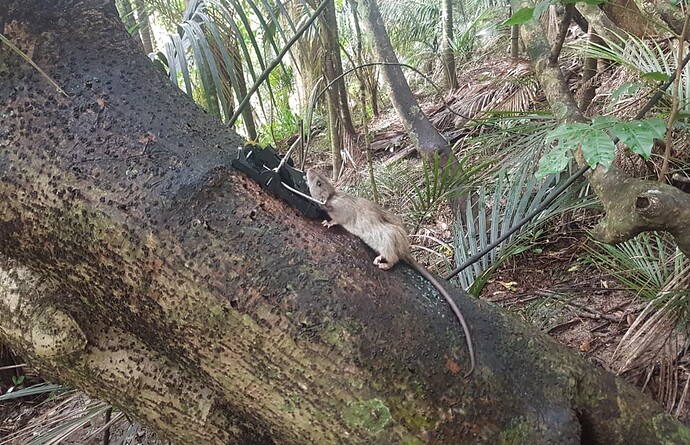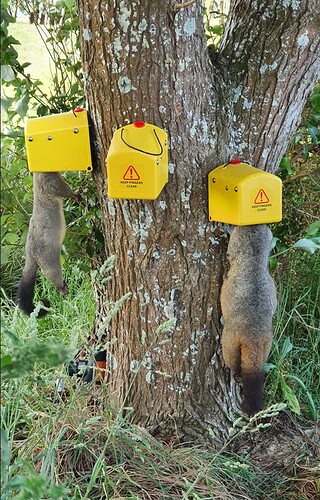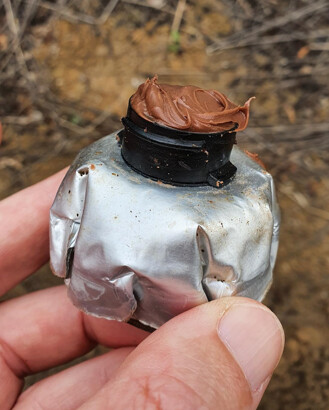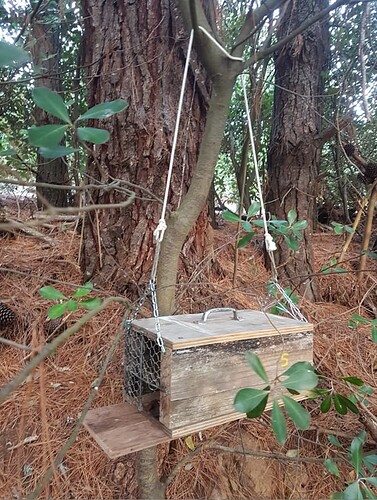This was motivated by this thread about problem with the D-Rat traps and related threads like this one about problems with possum traps, I thought I’d put together a summary of trap experiences in case it’s useful for others. Listed in order from the worst to… well, the least bad really. Feel free to add your own comments on traps you use.
Rat traps
Jaw-style traps: These are the family of traps that look a bit like a shark’s mouth, a row of plastic serrations along the top and bottom and a long coil spring that flaps the lid shut on anything that triggers it, as opposed to the powerful torsion spring and kill bar used on standard traps. The Mitre 10 Swissinno and house brand Number 8 Rat Trap are examples of this style. These are comically ineffective at doing anything other than scaring the intended target, since having a lid flapped shut on you has virtually no long-term effect. A thrush somehow got in through the bird netting to one of these and triggered it. Opened the flap and it immediately flew off with barely a feather out of place.
Old-fashioned wooden traps: In theory pretty good, except that modern manufacturing has made them almost useless. Traditionally the wire that made up the trigger bar was severed with cutters that left a slight raised lip which hooked onto the trigger plate, or alternatively had a bend in them that had the bar come up into the trigger plate at an angle (better traps like the Victor still have this). Generic cheap traps are made with a straight trigger bar with a smooth rounded edge that slides off the trigger plate by itself, making it a huge pain to set and prone to self-triggering at random times.
The Big Cheese: I haven’t tested these since I was underwhelmed when I saw them at Mitre 10, but trap expert Shawn Woods has and found them to be rubbish.
Snap-E and variants: A modern version of the above traditional wooden trap. This fails in a different way, the wooden traps have tiny trigger plates that guarantee the rat will have its head under the kill bar when it comes down. With modern plastic manufacturing you can make the trigger plate extend all the way to the edge of the trap, which makes it almost impossible for a rat to get its head in far enough to be caught by the kill bar when it comes down. Short of the rat launching itself bodily into the trap in the hope of being far enough in before it triggers that it’ll be killed, I can’t see how these could trap anything.
D-Rat: The high-end version of the Snap-E. Same problem with the trigger that makes it almost useless for its intended purpose, but it has other nice design elements like a shroud that surrounds most of the trap, an ability to unset it without triggering it, and nice mounting options.
Felis Domesticus: Low-tech trap that’s very effective at getting rats initially but tends to become less so with age. Expensive to maintain, but definitely the best-designed rat trap I’ve found so far.
Not tried: Goodnature A24 (see the notes on the Goodnature possum trap below), Victor Professional/Modified Victor (on order, held up by Christmas/New Year), T-Rex (which I don’t have).
Possum traps
Goodnature A12: High-tech trap that uses a CO2-driven captive bolt to kill possums. Unfortunately since possums can’t read they can’t figure out how to use this trap.
Trapinator: Another trap that looks good in theory but is completely useless in practice. The problem with these is that the trigger mechanism is so insensitive that they’re almost impossible to set off, the possums simply eat the bait out of them without setting them off. At one point, after rebaiting it maybe a dozen times, I just left it set up, then some time later took it down, cleaned it out, and moved it to a different location. Only then did I realise that the entire time I’d been monkeying with it it was fully armed. I even tried putting some shims under the trigger bar to force it down a bit more into the about-to-trigger position, but it didn’t help.
Flipping Timmy: The tree-based version of the traditional ground-based Timms. A good idea in theory but a major pain to arm. With the standard Timms you put your knee on it and pull the cord up, with the Flipping Timmy there’s no way to do this, you end up having to reach inside to start moving the trigger bar across and then once it’s part-way across and there’s less resistance awkwardly pulling the cord around the side to fully arm it.
Timms: The gold standard. Easy to set, easy to use, just works.
Crossbow upgraded with cheapie airsoft accessories (RDS and spotting torch): Well, it’s killed more possums than even the Timms so far, so it deserves honorable mention here.






